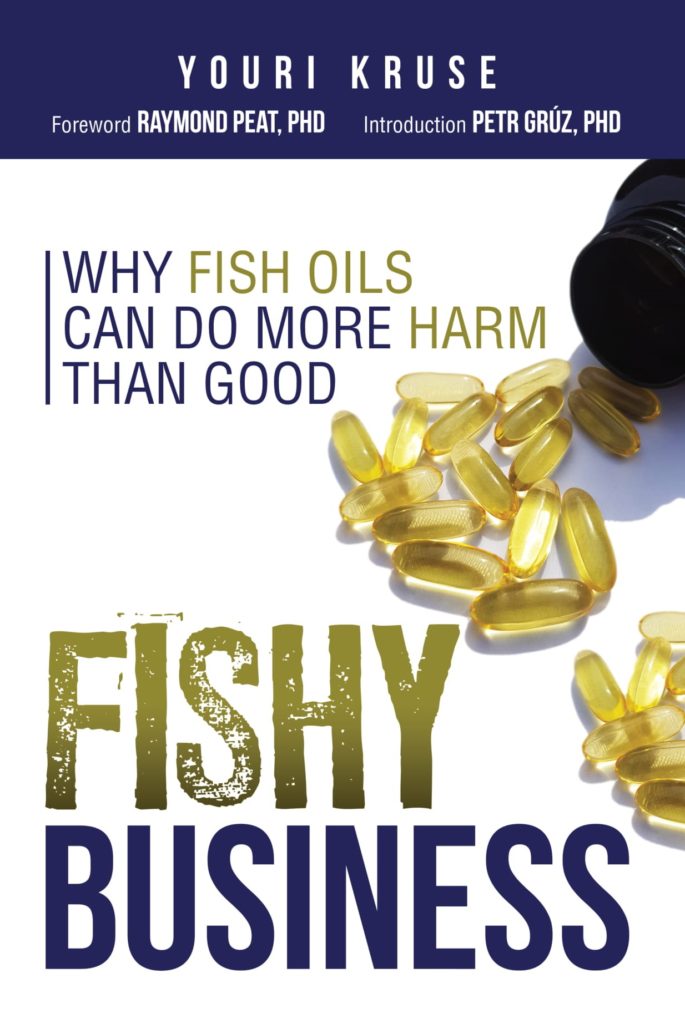The inner membrane of the mitochondria has a high amount of a phospholipid called cardiolipin. Cardiolipin is quite unique as it is associated with longevity. One possible way to have a long and healthy life is to keep high levels of cardiolipin. Cardiolipin synthesis seems to be mainly regulated by thyroid hormone(s). When thyroid function is high, cardiolipin synthesis is increased, and when thyroid function is decreased, cardiolipin synthesis decreases[i][ii]. The thyroid works, in many ways, in the opposite direction to the polyunsaturated fatty acids (PUFA). As the thyroid increases heat, PUFA tends to reduce it.
In hypothyroid conditions, unsaturated fats tend to be made, while a high thyroid function favors the creation of saturated fats or omega-9 fatty acids. Both saturated fats and omega-9 fatty acids are more resistant to heat and light. Fish oil has a limited role concerning thyroid health as it protects against the anti-thyroid actions of omega-6, but seems to have many anti-thyroid effects by itself. From studies with rats, we can see that fish oils can decrease both T4 (thyroxine) and the active T3 hormone (triiodothyronine)[iii].
Fish oil in the bloodstream as non-esterified unsaturated fatty acids inhibit the binding of T4 to thyroxine-binding globulin. At the same time, saturated fats are found to be inactive[iv][v]. After the thyroid is removed, the shorter fatty acid makes place for the longer fatty acids[vi].
Fish Oils And Thyroid
Many studies found that the unsaturated fatty acid inhibits the binding of thyroid hormone; these unsaturated increase their thyroid-inhibiting abilities as the fats have more double bonds[vii]. Studies have found that unsaturated fats are uniquely suppressive of thyroid function through inhibiting the actions of the active thyroid hormone[viii]. Polyunsaturated fats (mostly omega-6) have been used by the Agrarian Industry since the 1950s to fatten the animals by lowering their thyroid function – one researcher noted to improve stock conditions by:
“feeding them anti-thyroid drugs such as high levels of polyunsaturated fatty acids in diets.”[ix]
Scheele, Cor W. Ascites in chickens : oxygen consumption and requirement related to its occurrence / Cor W. Scheele – [S.I.: s.n.] Thesis Landbouwuniversiteit Wageningen. – With réf. – With summary in Dutch. ISBN 90-5485-499-5
Fish oil can increase T4, while leaving T3 the same, possibly increasing the RT3 (anti-thyroid hormone)[x]. The ease with which the unsaturated fats break down and increase reactive oxygen species can quickly decrease thyroid function. For example, increased lipid peroxidation and lowering of T3 are associated with spontaneous abortions[xi].
If you like the information, buy the book here

[i]Paradies G, Petrosillo G, Ruggiero FM. Cardiolipin-dependent decrease of cytochrome c oxidase activity in heart mitochondria from hypothyroid rats. Biochim Biophys Acta. 1997;1319(1):5–8. doi:10.1016/s0005-2728(97)00012-1
[ii]Schlame M, Hostetler KY. Cardiolipin synthase from mammalian mitochondria. Biochim Biophys Acta. 1997;1348(1-2):207–213. doi:10.1016/s0005-2760(97)00119-7
[iii]Mohan PF, Phillips FC, Cleary MP. Metabolic effects of coconut, safflower, or menhaden oil feeding in lean and obese Zucker rats. Br J Nutr. 1991;66(2):285–299. doi:10.1079/bjn199100
[iv] Lim CF, Munro SL, Wynne KN, Topliss DJ, Stockigt JR. Influence of nonesterified fatty acids and lysolecithins on thyroxine binding to thyroxine-binding globulin and transthyretin. Thyroid. 1995;5(4):319–324. doi:10.1089/thy.1995.5.319
[v] Tabachnick M, Korcek L. Effect of long-chain fatty acids on the binding of thyroxine and triiodothyronine to human thyroxine-binding globulin. Biochim Biophys Acta. 1986;881(2):292–296. doi:10.1016/0304-4165(86)90016-4
[vi]Greenbaum AL, Walters E, McLean P. The effect of thyroidectomy on the pattern of fatty acids synthesized by mammary gland from lactating rats. Biochem J. 1967;103(3):720–723. doi:10.1042/bj1030720
[vii] Benvenga S, Li Calzi L, Robbins J. Effect of free fatty acids and nonlipid inhibitors of thyroid hormone binding in the immunoradiometric assay of thyroxin-binding globulin. Clin Chem. 1987;33(10):1752–1755
[viii]Clarke SD, Hembree J. Inhibition of triiodothyronine’s induction of rat liver lipogenic enzymes by dietary fat. J Nutr. 1990;120(6):625–630. doi:10.1093/jn/120.6.625
[ix] Scheele, Cor W. Ascites in chickens : oxygen consumption and requirement related to its occurrence / Cor W. Scheele – [S.I. : s.n.] Thesis Landbouwuniversiteit Wageningen. – With réf. – With summary in Dutch. ISBN 90-5485-499-5
[x]Taraghijou P, Safaeiyan A, Mobasseri M, Ostadrahimi A. The effect of n-3 long chain fatty acids supplementation on plasma peroxisome proliferator activated receptor gamma and thyroid hormones in obesity. J Res Med Sci. 2012;17(10):942–946
[xi]Ramandeep K, Kapil G, Harkiran K. Correlation of enhanced oxidative stress with altered thyroid profile: Probable role in spontaneous abortion. Int J Appl Basic Med Res. 2017;7(1):20–25. doi:10.4103/2229-516X.198514